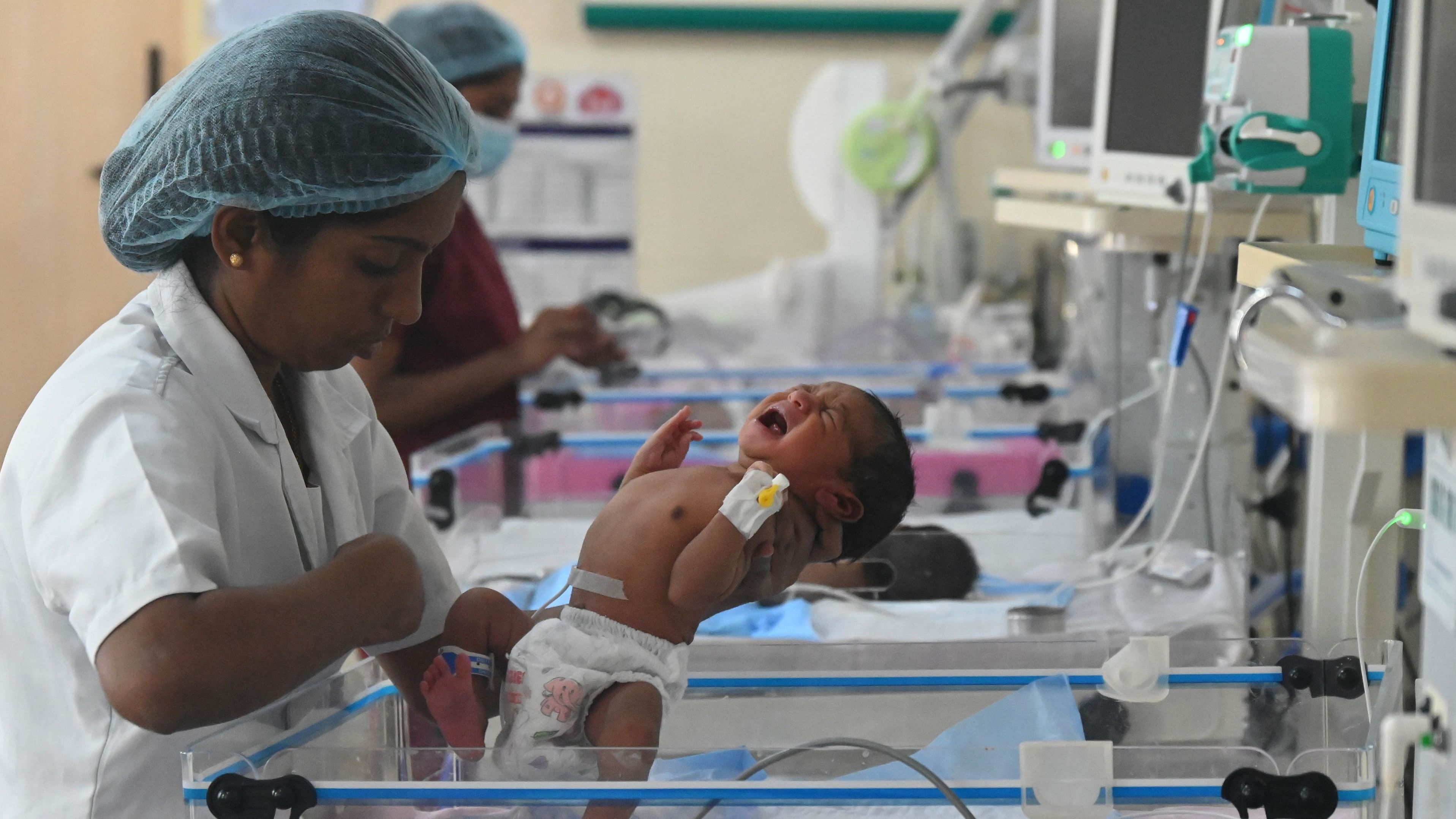
A special newborn care unit at the government district hospital at Chikkaballapur district.
Credit: DH Photo/ B K Janardhan
Bengaluru: Doctors at the high-risk pregnancy ward (HRP) at Vani Vilas Hospital, in Bengaluru, move swiftly from one patient to another, chalking out a plan of action for women about to go into labour. The ward is filled with pregnant women with hypertension, diabetes, anaemia and other comorbidities.
A significant portion of women from this ward go into labour before the completion of 37 weeks of pregnancy, giving birth to preterm babies. Twenty-seven-year-old Vasantha from Bengaluru Rural was one of many patients recently admitted to the hospital due to high blood pressure. The doctors gave her immediate medical attention and she was able to deliver her baby safely, albeit prematurely at seven months.
“I started vomiting and had developed high blood pressure. We went to the government hospital in Nelamangala. From there, they sent us to Bengaluru in an ambulance,” says Vasantha, while she recuperates in the postnatal ward.
Vani Vilas sees hundreds of patients from in and around the city, many of whom are sent here on referrals from other government hospitals. According to the medical staff, the hospital roughly conducts about 1,200 to 1,400 deliveries every month, of which about 40 per cent are preterm deliveries.
A recent World Health Organisation report, ‘Born too soon: A decade of action on preterm birth’, points out that India witnessed the highest number of preterm births in 2020 (3.02 million, accounting for more than 23 per cent of all preterm births worldwide).
The report also cites preterm birth as the single largest cause of mortality in children under five years. “Neonatal conditions are also the leading cause of lost human capital in the most recent estimates of the global disease burden,” the report says.
In 2020, an estimated one million newborns died due to complications arising from preterm birth, accounting for one baby every 40 seconds, according to the report.
Dr Sahana Devadas, Professor of Paediatrics and neonatologist, Vani Vilas hospital lists out several factors responsible for preterm births. These include early deliveries (where the mother is younger than 18 years), late deliveries (above 35 years), obesity in pregnant women, underweight, anaemia, diabetes, lifestyle-related stress, urinary tract infections (UTIs), hypertension among other reasons.
Both urban and rural women are at risk of preterm deliveries says Dr Hema Divakar, a senior gynaecologist. “Anaemia occurs in urban women too due to dietary choices. Obesity is another problem. Further, fertility treatments such as IVF hasten the chance of multiple pregnancies and increases preterm deliveries,” she observes.
Ensuring safe preterm births requires the right kind of infrastructure at the right time as such newborns are at a high risk of respiratory complications and other comorbidities.
According to data from the National Health Mission (NHM), neonatal mortality in India is 23 per 1,000 live births at present. The global goal is to bring it under 10 mortalities by 2030. The Union government has put in place several maternal and infant care programmes to reduce mortality and improve maternal health over the past decade.
The state government has also put in place a three-level healthcare system, explains Dr Basavaraj, deputy director of child health in Karnataka. Newborn care corners are available at all delivery points. There are 169 newborn stabilisation units in Karnataka, meant to observe newborns at taluk hospitals and community health centres. “There are 50 special newborn care units (SNCUs) in the state, where round-the-clock specialised care is provided for newborns,” he adds.
Long way to go
Despite these elaborate programmes, complications leading to and arising from preterm births persist. In the past decade, there has been no measurable change in the global preterm birth rates even in regions with high burdens, according to the WHO report.
An investigation by DH of a few taluk and district hospitals revealed that even though medical institutions had the necessary machinery in place, trained personnel to operate them and interact with patients were absent. A case in point is the Gudibande Taluk Hospital in Chikkaballapur district.
The hospital has one paediatrician, a gynaecologist and an anaesthetist. One staff member explains just how stretched they are for manpower: “When the gynaecologist is off duty and a high-risk pregnancy case arrives, we immediately refer them to the district hospital as we do not want to risk the safety of either the mother or the baby.”
Further, even when the doctor is present, they are forced to perform roles outside their areas of specialisation, owing to the shortage of resources. “There are 15 nurses who have to take care of pregnancy, neonatal, OT and all other wards. We definitely cannot risk neonatal care which requires round-the-clock monitoring,” the staff member adds.
The Chikkaballapur District Hospital, which sees referrals from taluk hospitals and patients from the neighbouring Andhra Pradesh, is almost always overcrowded. There are 14 neonatal cribs in the hospital’s SNCU facility. The medical staff here say that these beds are always full.
“Sometimes there are more than 25 babies, with two or sometimes even three babies in one crib. When we are full, we refer patients to Vani Vilas in Bengaluru or other private hospitals as patients can access these hospitals with Ayushman Bharat – Arogya Karnataka Scheme (AB-ARK scheme) cards.”
The newly-established Mother and Child Hospital in Gauribidanur is the next resort for people in Chikkaballapur. However, the hospital has been temporarily clubbed with the Chikkaballapur District Hospital. For any preterm complications, the doctors shift patients to the district hospital.
Regional disparities
Karnataka's hinterlands still lack quality healthcare support. Dr Tanya Sheshadri, faculty at the Institute of Public Health, works with the Soliga community in Chamarajanagar, helping the community access healthcare. She explains how access to hospitals is a huge challenge for Soliga women living in forested areas, particularly if they develop labour pains at night. “The 108 ambulance takes 90 minutes to reach. There are only four to five ambulances for the entire district. As a result, the deliveries happen either during the transit or at home. There is a high potential for stillbirths,” Sheshadri says.
Moreover, the taluk hospitals are equipped only to handle normal deliveries. “Our taluk hospitals are unable to cater to complicated caesareans or cases that require blood transfusions and have other complications. Many times, owing to lack of coordination between taluk and district hospitals, patients are referred from a Primary Health Centre (PHC) to a taluk hospital, then to the district hospital only to be finally referred to Cheluvamba hospital in Mysuru,” she adds.
Urban islands
Even in urban areas that may have a higher concentration of hospitals, protection procedures for preterm babies may not be sufficiently accessible. Lack of awareness is a contributing factor to complications with newborns – as was the case with Sumathi (42) (name changed), grandmother to a one-year-old baby girl. Sumathi’s granddaughter was born prematurely at seven months and weighed less than a kilo at birth.
Soon after delivery, the child was abandoned by the mother owing to marital issues. Sumathi shouldered the responsibility of bringing up her granddaughter. While she has been taking the baby to the doctor regularly, she has several misconceptions about preterm births. “We are afraid that vaccination will harm our granddaughter who was born too fragile,” she says. Sumathi remains fearful even as local Anganwadi staff encourages the family to vaccinate the baby at the earliest.
A 2021 review of scientific literature found that although routine childhood vaccinations are recommended regardless of gestational age or birth weight, vaccination is often delayed even though infections have more serious consequences in preterm and low birth weight infants.
Action needed
To address preterm birth-related complications, there is a need to establish preterm delivery corridors on par with heart corridors, says Dr Sheshadri. “The mother-to-be should reach a place with a functional neonatal unit at the earliest. This can happen even with the existing infrastructure, with adequate coordination,” she says.
Strengthening the doctor-patient relationship will also help. In rural areas, where the primary relationship of the pregnant woman is with the doctor at PHCs, the connection ends when pregnant women are referred to taluk or district hospitals. There is a need for active communication channels among doctors at different levels of care, she says.
Dr Prathap Chandra is a neonatologist and a decision review committee member of the Neonates Foundation of India, a non-profit that coordinates neonatal intensive care units on wheels to transport babies from remote areas to partner hospitals. He advocates for the creation of hubs in different regions of the state to ensure proper transport to newborns. “If there are three medical colleges, all of them should participate in the transport of these babies. All it requires is some coordination,” he says.
He adds that there is a need to upgrade government neonatal ambulances as well. “These ambulances have rudimentary incubatory services, with no ventilator facilities, which are crucial for preterm babies.” As a result, there is a high dependence on private neonatal ambulances.
Nurses also need to be trained exclusively in dealing with neonatal transport, he adds. “In transporting vulnerable babies we should ensure temperatures and sugars are within normal limits. This will improve the morbidity and mortality in the newborn period,” he says.
To reduce preterm births at the public health level, there is a need to improve women’s health right from adolescence. The incidence of anaemia and hypertension, two major contributing factors for preterm births, also remain high. Forty-eight percent of women in Karnataka have anaemia, and 13% of women aged 15 to 49 years have hypertension, according to data from the National Family Health Survey 5 (NFHS-5).
Women’s health
Public health expert Dr Sylvia Karpagam opines that policymakers need to be aware of preventing and managing preterm labour and social determinants of health. “Pregnancy is but one event in a woman's life. You cannot address the issue of preterm deliveries without addressing the overall health of a woman and crucial social determinants of health,” she says.
Addressing the overall health requires a comprehensive nutritional approach and it cannot be isolated interventions designed to cure anaemia or hypertension. For instance, there is an emphasis on the distribution of vegetarian food through midday meals, and maternal and child health programmes.
These meals are devoid of several nutrients and proteins that are essential for the absorption of fat-soluble vitamins.
“The government is denying nutrition to the poor by creating a taboo around the consumption of meat and eggs,” she points out.
